|
MT. TOM and Mount Tom Railroad, ca. turn of century
THE MOUNTAIN
IN Massachusetts, near to the cities of Holyoke and
Northampton, close by "the lovely vale of the sweetest stream
that flows, the winding and willowy-fringed Connecticut,"
stands Mt. Tom. It is the highest peak of the Mt. Tom range. It
dominates the beautiful and picturesque section of country of
which it is the central figure. From the south it seems solid,
bold and defiant against the sky, a dome-shaped monument of trap-rock
and sandstone suggestive of the times when nature was struggling
to rescue from the great prehistoric ocean of ice and water the
fair country of which it is a part, and to close the volcanoes
that were active about its base. For lovers of natural scenery
Mt.Tom has a perfect location, with the peculiarity of being high
above the general level of the country near it.
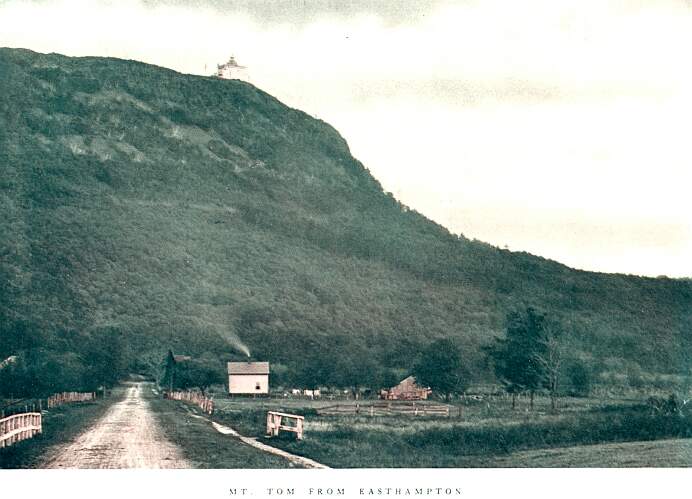
THE SUMMIT
The summit of Mt. Tom was not easily accessible until
the construction of the Mt. Tom Railroad in the year 1897. Now,
the street-cars of Holyoke (which connect with the Springfield,
Northampton, Westfield and Amherst systems of street-cars, and
with the Boston & Maine and N. Y., N. H. & Hartford railroads)
run to the lower station of the Mt. Tom Railroad, and in less
than ten minutes afterwards the mountain cars deliver their passengers
on the summit. The Mt. Tom Railroad is a cable-trolley-electric,
modern mountain railway. The cars are models of taste and finish,
excelling in size, proportions, and beauty of all the mountain
cars in this country. The electric power is furnished from a power-house
five miles away. Each car is equipped with electric brakes, also
with a powerful automatic grip-brake (which is governed by a regulator)
which causes heavy, strong jaws to grip a safety third rail of
the track whenever the wheels exceed a certain speed. Besides
these brakes, there is a brake upon the cable at the top of the
incline, also the usual electric-car hand-brakes on each car.
The "turn-out," half-way up the mountain, is an ingenious
arrangement for allowing cable-connected cars to be used on a
single-track, standard-gauge railroad. The roadbed is of trap-rock,
and the construction is strong and substantial in every way. The
cars move up the rocky slope by a grade so easy as not to suggest
even the fear of giddiness to the most timid. The maximum grade
is but 21 per cent.
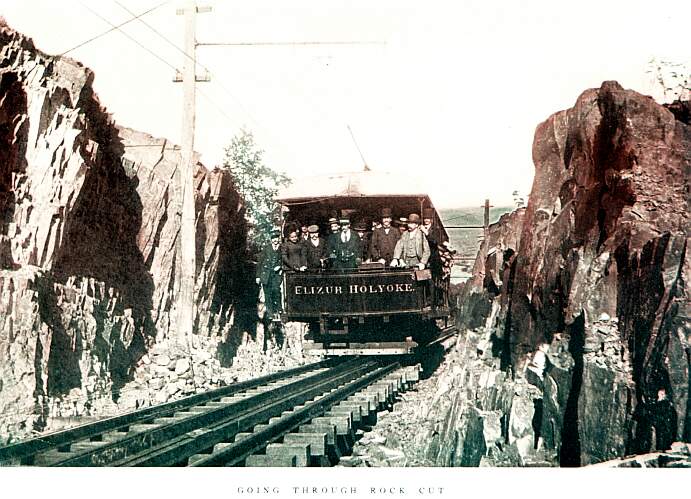
THE SUMMIT HOUSE
The Summit House is a large, solidly built structure,
76 feet wide by 104 feet long, three stories high. Wide piazzas
surround two stories and the upper story is a large observation
room (48 x 80 feet), surrounded by windows of polished plate-glass.
This observation room is furnished with numerous telescopes for
the use of visitors. Maps of the United States Topographical Survey
show the country with all the details of water, relief, and culture,
on a scale of about one mile to the inch, from Boston Bay to the
Hudson River and from Long Island Sound northerly into Vermont
and New Hampshire.
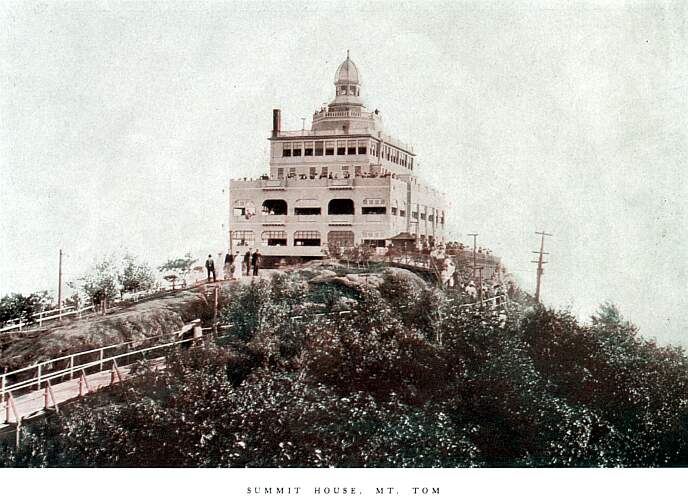
In the lower story is a cafe where excellent meals are served
at all times, in charge of Bowker & Co., proprietors of Hotel
Norwood, Northampton, of the Hotel Hamilton, in Holyoke, and of
the Hotel Winthrop, in Meriden, Conn., all well-known hotels of
New England. Visitors will be sure of good service and an excellent
cuisine. There is also a lunch-counter, and a beautiful rustic
pavilion for those who bring their own lunches. An Angelus Orchestral,
a concert-size Regina Musical Cabinet, graphophones, and a modern
kinetoscope are in the building. A long-distance telephone connects
with the Holyoke and the Springfield exchanges.
THE VIEW
The view from the summit of Mt. Tom is the prominent feature,
as it is the most diversified and beautiful of any mountain view
in the world. To some it suggests the Drachenfels on the Rhine,
and to others Stirling Castle, but comparisons are not necessary,
so much is true, and more, that in forty minutes from Holyoke
one may sit above the din and heat of a summer day, in the world
and yet apart from it, with as fine a view as the earth affords,
satisfied by the variety presented.
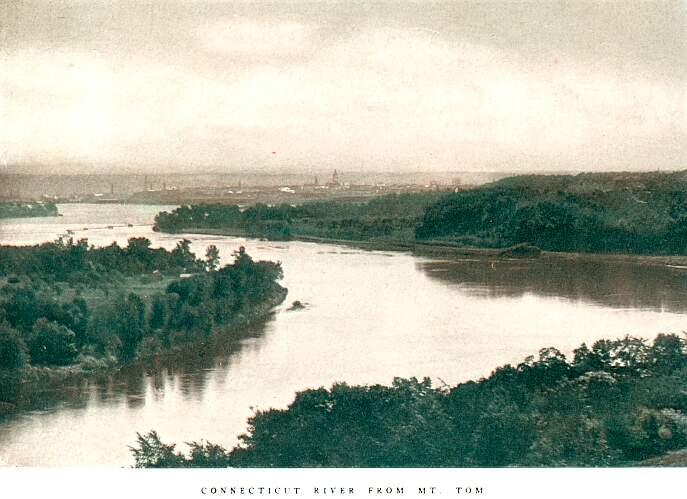
"Nature is saturated with beauty," writes a prominent
author, and those whose perceptive powers are not at fault can
not but appreciate the beauty of nature in the splendid panorama
that surrounds Mt. Tom. In late afternoon, when the mist and light
make the glory of a summer sunset, the feeling uppermost is one
of enjoyment and admiration, and one forgets himself in the delights
of a bird's existence, for we must look from a great height to
realize, in a flood of sensations, that the poetry of air is liberty.
Nature dips her pencil in many colors to tint the landscape
from April to November. It is a long and varying scale from the
delicate tint of the first leaves of the birches to the brilliant
colors of the fall maples. Each day has its peculiar beauties.
The intermittent shadows and sunlights of a day in spring, chasing
each other across fields and mountains, tint a picture that art's
pencils and pigments can not equal. A glimpse of this picturesque
portion of our planet makes the excitement and annoyances of business
and social life appear unreal and ridiculous. The sense of proportion,
gained here, is one of the signs of sanity and health. "Nature
is ready to mother us all if we will only let her. The quietude
of her heights is medicine for the fret and fever of life."
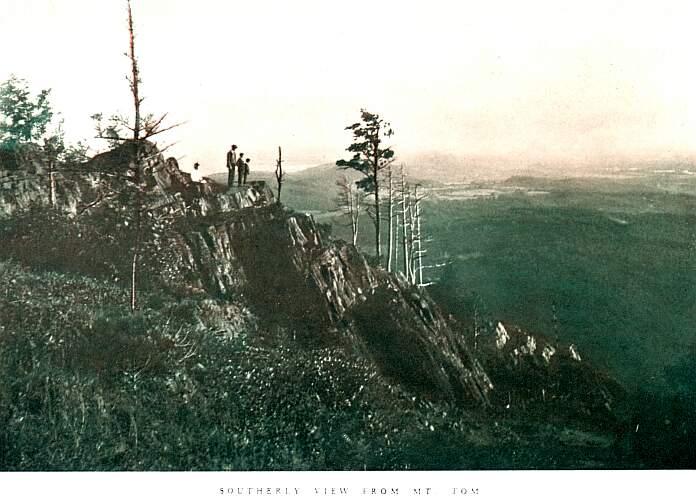
The view from Mt. Tom is one of infinite variety. It is a rare
pastime to watch the, sky from the piazzas, or from some cozy
nook of the palisaded trap-rock, and see the glorious cloud-pictures,
with their ever-varying effects, on favorable days for vapory
formations.
Afar off (fifty-one miles) to the north, in the Granite State,
is the massive bulk and impressive outlines of Monadnock (3,186
feet) with its rock-armored peak, a kingly mountain, from this
distance a great softened shadow against the sky. To the northwest
is "Haystack," near Wilmington, Vt., and Stratton Mountain
miles beyond "Haystack." On a very clear day Mt. Ascutney,
Vermont (3,228 feet), eighty-five miles distant, can be seen through
the most powerful telescope. To the east is Wachusett (2,108 feet),
sixteen miles northerly of Worcester. To the west is Greylock,
in Berkshire (3,535 feet), the highest land in Massachusetts.
Near Greylock is the tunnelled Hoosac Mountain (2,480 feet), and
farther to the north is Marlboro Mountain. Nearer is Bald Mountain
(1,690 feet), near Shelburne Falls, and Mt. Grace (1,628 feet)
near Warwick, and Mt. Tobey (1,275 feet). Near Mt. Tom (1,218
feet) are Mt. Holyoke (984 feet) and Norwottuck (1,115 feet).
Northerly, beyond the Sugar Loaf mountains, is Greenfield, a typical
New England shiretown.
Five miles away is Northampton, with the buildings of Smith
College in plain view, also the state asylum for the insane. Easterly,
less than four miles away, is South Hadley where Mary Lyon, October
3, 1836, founded Mt. Holyoke College. The brownstone tower, with
large clock-dials, is on the Administration building. It doesn't
seem to be three and one-half miles to the city-hall tower of
Holyoke, the great papermaking city of this country. A leading
papermaker of Holyoke once issued a standing challenge to "All
England" to produce better paper than is made at Holyoke.
Beyond is Chicopee and Chicopee Falls, producers of cotton cloth
and automobiles. Southerly, on a tower of the United States Armory
at Springfield, floats the flag of our country. On clear days,
nearly thirty-five miles to the south, the golden dome of the
Connecticut State Capitol of Hartford can be plainly seen. West
of the Mt. Tom range is Westfield, whose whips are snapped and
cigars smoked all over the country. Near the foot of the mountain
lies Easthampton, where Samuel Williston devoted some of the profits
of his button manufactory to the building and endowment of Williston
Seminary. To the south is Suffield Institute and to the east is
the Wesleyan Seminary, at Wilbraham. It is doubtful if there is
another section in New England where so many educational institutions
can be seen from one summit. To the northeast is Amherst with
its two colleges, and Sunderland, whose specialty is onion culture,
but no odor of them is wafted to Mt. Tom. One can see the Deerfield
of Indian history, and Hadley, where the Cromwellian regicides
led the settlers against an Indian attack, and where "fighting
Joe Hooker" was born. Peru church is literally nearer the
heavens than any other church in Massachusetts, yet Blandford's
steeple is ambitious. Goshen, Haydenville, Williamsburg, Leyden,
Shutesbury, Pelham, New Braintree, North Brookfield, Ludlow, Granby,
Belchertown, Longmeadow, Enfield, Thorndike, Thompsonville, Rockville,
Somers, Feeding Hills, West Springfield, Mittineague, East Hartland,
Tolland, Middlefield, Westhampton, Southampton, Florence, Leeds,
and Bay State are in view, besides many other places which may
be pointed out to visitors by the person in charge of the observation
hall. Said King Lear,
" I'll look no more;
Lest my brain turn, and the deficient sight
Topple down headlong."
Mt. Tom is the geologist's paradise. The summit rock shows
distinctly the striæ, or scratches of the debris of the
glaciers or ocean of ice that once covered this whole country.
Granite boulders from afar north found resting-places along the
mountain side; a fine specimen may be found on "Little Mountain,"
and a "bird-track" of huge size can be seen in a sand-stone
slab in front of the Summit House, brought thither from Mountain
Park.
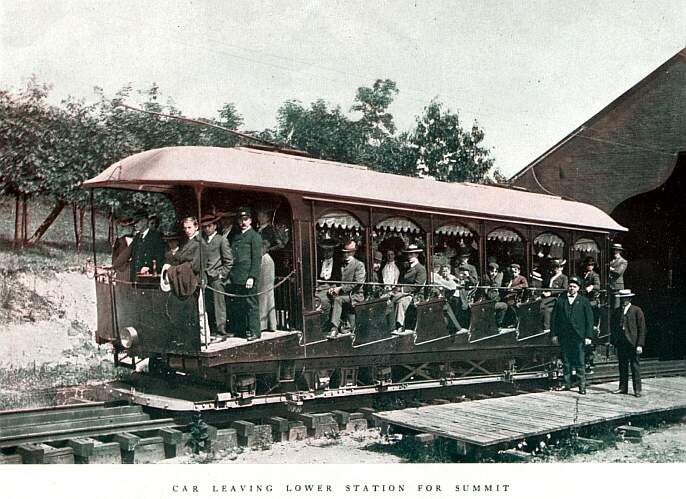
The electric carfare from the Holyoke post office to the foot
of Mt. Tom is 5 cents. The fare on the Mt. Tom Railroad is 25
cents for the round trip, which includes free use of grounds,
pavilion, use of telescopes, etc. Fares to summit of Mt. Tom,
and return, on electric railway are as follows: Springfield, round
trip, 55 cents; Westfield, 65 cents; Northampton, 45 cents; Amherst,
65 cents; Easthampton, 45 cents; Williamsburg, 55 cents; Chicopee,
45 cents; Chicopee Falls, 45 cents.
MOUNTAIN PARK
Cars to Mt. Tom pass through "Mountain Park,"
probably the largest street railway park in the world, being owned
by the Holyoke Street Railway Company and comprising more than
400 acres. This park extends from the base of Mt. Tom to the Connecticut
River, and its extensive natural beauties have been added to by
carefully planned improvements without detracting from the charms
of its wildness. Within its limits there has been uncovered a
large tract of sandstone, bearing footprints made thousands of
years ago, outlasting every work of man.
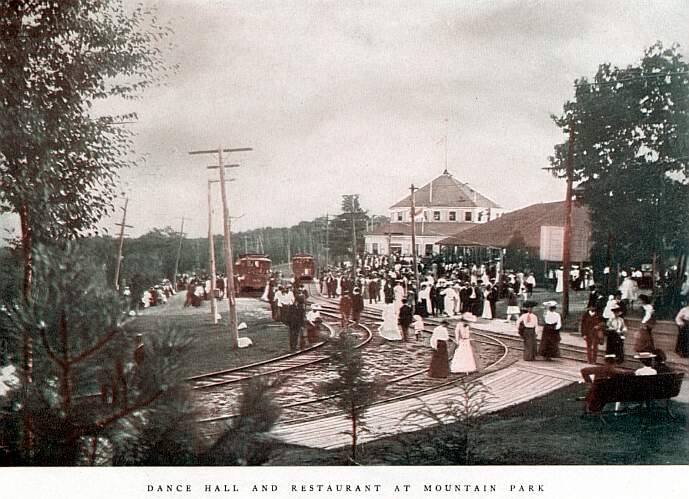
During summer seasons, in the Mountain Park Casino (which has
a seating capacity of 2,500), musical comedies and operas are
daily presented, afternoons and evenings. Besides pleasant walks,
observation towers and tables for picnic-parties, there are flowers
in profusion, a deer park, elk, a bear-den, coons, monkeys, etc.
Also a restaurant building, pavilion for dancing, merry-go-round,
photograph gallery, Y. W. C. A. cottage for women and children,
and the lower station of the Mt. Tom Railroad.
Stories Page | Contents Page
|







